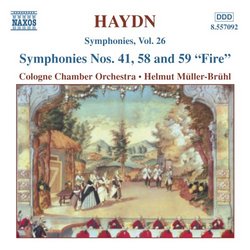| All Artists: Franz Joseph Haydn, Helmut Müller-Brühl, Cologne Chamber Orchestra Title: Haydn: Symphonies Nos. 41, 58 and 59 "Fire" Members Wishing: 0 Total Copies: 0 Label: Naxos Release Date: 5/20/2003 Genre: Classical Styles: Historical Periods, Classical (c.1770-1830), Symphonies Number of Discs: 1 SwapaCD Credits: 1 UPC: 747313209224 |
Search - Franz Joseph Haydn, Helmut Müller-Brühl, Cologne Chamber Orchestra :: Haydn: Symphonies Nos. 41, 58 and 59 "Fire"
 | Franz Joseph Haydn, Helmut Müller-Brühl, Cologne Chamber Orchestra Haydn: Symphonies Nos. 41, 58 and 59 "Fire" Genre: Classical
|
Larger Image |
CD Details |
CD ReviewsExploring the Haydn Symphonies -- Nos. 41,58,59 Robin Friedman | Washington, D.C. United States | 03/16/2006 (5 out of 5 stars) "If you love music and wish to explore works beyond the handful of pieces in the standard repertoire there are two choices. First you may broaden your exposure to composers and periods that are unfamiliar. Second, you may deepen your understanding of composers or periods you love by exploring unfamiliar works.
Although it is best to combine the two approaches, I have been enjoying listening to some of the lesser-known symphonies of Haydn and sharing my experiences on this site with other listeners. It is a fertile field indeed with 104 numbered symphonies, most of which, fortunately, have been recorded several times. The CD I am discussing here is part of the ongoing Naxos cycle of the complete Haydn symphonies. Helmut Muller-Bruhl conducts the Cologne Chamber Orchestra in spirited performances of symphonies nos. 41, 58, and 59. These symphonies date from 1768 -- 1769, a period sometimes referred to as within Haydn's "strum and drang" period due to the several minor-key works or movements he wrote during this time such as the "Trauer" symphony, no. 44 and the "Farewell" symphony, no. 45. There is little of storm and stress in these three works. But they are full of lovely and innovative music. Symphony no 41 in C major is a festive, fanfare symphony with prominent parts for trumpet and tympani. Haydn generally composed works of this form in C major. The most famous example is the "Maria Teresa" symphony, no. 48, composed at about the same time as no. 41. The work opens with a single large "Boom" in the stings followed by a soft answer. Listen for the false reprieve (a return of the opening "Boom!" and answer) shortly into the development section. Also, you can hardly miss the big drumbeats at the close of the movement. The second movement features the use of the flute, relatively uncommon in Haydn's early symphonies, for some lovely embroidered passage work. The minuet opens with a single loud note that recalls the opening passage of the symphony while the trio is given over to horns and oboe. The finale is a quick, propulsive, ceremonial movement in triplets with the trumpet playing a large role in the close. Symphony no. 58 in F major is, on the whole, a quiet, elegant, exquisitely balanced work. The opening movement features a flowing theme followed by a second theme dominated by triplets. The second movement is for strings alone, as is common in early Haydn symphonies. It features a opening walking theme followed by a lyrical, almost sighing secondary theme. The minuet is known as a "limping" minuet for its unusual, halting rhythm featuring strings with horns in the background. There is a startling, angular trio in the minor key. The finale moves very quickly through a number of moods and dynamic changes and surprising changes of key. The best-known work on this CD is the "Fire" symphony, no. 59 in A major. As with several Haydn symphonies, the "Fire" probably originated as overture and between-the-acts music for a play at Esterhaza. Thus, it features a lively-curtain raising opening movement with many twists and turns which fades away into a quiet close (as the curtain rises). In the slow movement, Haydn breaks new ground for himself as he integrates and fully develops two main themes. Haydn also shows an imaginative sense of orchestration in bringing in the oboes and the horns for a climactic moment near the end. The minuet and the trio are based upon the themes that Haydn used in the second movement, thus further integrating the work (possibly tying it in as well with its use as accompaniment to a stage-piece). The finale opens with a horn call followed by an answering phrase in the strings. As the movement progresses, Haydn gives a strutting figure to the oboes, which alternates,with humor and whimsy , with the horn passage and the string response as the symphony works to a close. These three varied, lovely symphonies are a delightful way to explore some less-familiar Haydn. Robin Friedman" |

 Track Listings (12) - Disc #1
Track Listings (12) - Disc #1